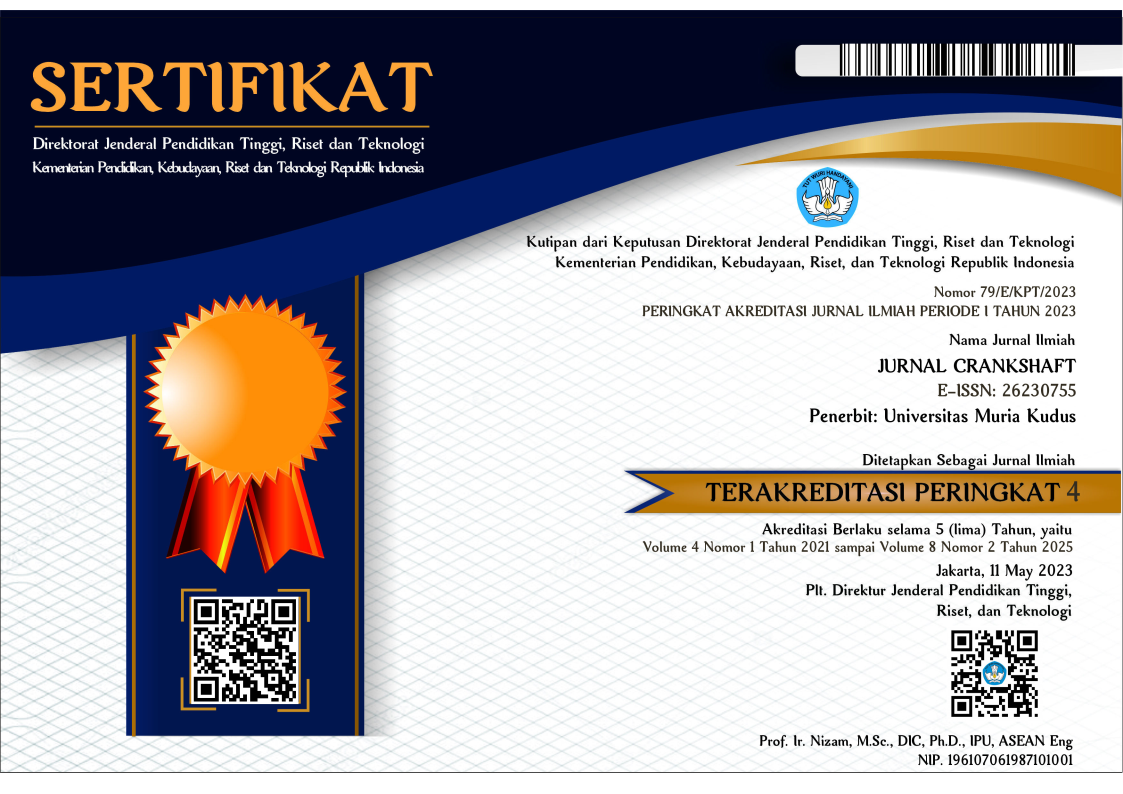Pengaruh grind size dan tipe portafilter terhadap kualitas espresso pada mesin espresso sistem pneumatik
Sari
Penelitian ini bertujuan untuk mengetahui pengaruh temperature, grind size dan jenis portafilter terhadap kadar total dissolved solids (TDS) dan extraction yield (EXT) dan menemukan pengaturan mesin kopi espresso sistem pneumatik yang optimal untuk mencapai kualitas terbaik. Pada penelitian ini dilaksanakan dengan menguji karakteristik kopi espresso yaitu kadar total dissolve solid (TDS) dan extraction yield (EXT) akibat pengaruh temperatur, grind size dan tipe portafilter. Desain eksperimen faktorial penuh (full factorial design of experiments - FFD) digunakan untuk mengidentifikasi variabel yang memiliki pengaruh yang signifikan pada kualitas espresso yang dihasilkan. Data penelitian diolah menggunakan analisa varian (analysis of variance - ANOVA) dengan bantuan perangkat lunak Minitab. Hasil penelitian menunjukkan bahwa temperature, grind size dan tipe portafilter secara statistik memiliki pengaruh yang signifikan dengan tingkat kepercayaan 100% dalam mempengaruhi kadar total dissolved solids (TDS). Grind size dan tipe portafilter secara statistik juga memiliki pengaruh signifikan terhadap extraction yield (EXT) dengan tingkat kepercayaan 100%. Sebaliknya, nilai p-value yang lebih tinggi untuk faktor temperatur menunjukkan bahwa faktor tersebut secara statistik tidak memiliki pengaruh signifikan terhadap extraction yield (EXT). Hasil optimasi respons untuk kadar total dissolved solids (TDS) dan extraction yield (EXT) menghasilkan niai composite desirability (D) sebesar 0,7255. Dari nilai tersebut dapat disimpulkan bahwa kondisi optimal yang ditemukan melalui plot optimasi cukup dapat diandalkan dan sesuai dengan model regresi yang telah diuji secara kredibel. Variabel yang dapat menghasilkan kadar total dissolved solids (TDS) dan extraction yield (EXT) paling optimal didapat dari pengaturan temperatur 1000C, grind size 2.8 dan penggunaan un-pressurized portafilter. Kadar total dissolved solids (TDS) dan extraction yield (EXT) yang dihasilkan dari metode respon optimasi ini masing-masing sebesar 11,5252% dan 22,348%.
Kata Kunci
Teks Lengkap:
PDFReferensi
[1] A. Parenti, L. Guerrini, P. Masella, R. Dainelli, and P. Spugnoli, “A new method for Espresso Coffee brewing: Caffè Firenze,” Journal of Agricultural Engineering, vol. 44, no. 2s, Sep. 2013, doi: 10.4081/jae.2013.294.
[2] A. N. Gloess et al., “Comparison of nine common coffee extraction methods: Instrumental and sensory analysis,” European Food Research and Technology, vol. 236, no. 4, pp. 607–627, Apr. 2013, doi: 10.1007/s00217-013-1917-x.
[3] A. Illy and R. Viani, Espresso Coffee The Science of Quality. Elsevier Academic Press, 2005. doi: 10.1016/b978-012370371-2/50004-4.
[4] Andrea Illy and Rinantonio Viani, “The Science of Quality,” 2005.
[5] G. Caprioli et al., “Optimization of espresso machine parameters through the analysis of coffee odorants by HS-SPME-GC/MS,” Food Chem, vol. 135, no. 3, pp. 1127–1133, Dec. 2012, doi: 10.1016/j.foodchem.2012.06.024.
[6] C. Sanz, L. Maeztu, M. Jose Zapelena, J. Bello, and C. Cid, “Profiles of volatile compounds and sensory analysis of three blends of coffee: Influence of different proportions of Arabica and Robusta and influence of roasting coffee with sugar,” J Sci Food Agric, vol. 82, no. 8, pp. 840–847, 2002, doi: 10.1002/jsfa.1110.
[7] M. Anese, L. Manzocco, and M. C. Nicoli, “Modeling the secondary shelf life of ground roasted coffee,” J Agric Food Chem, vol. 54, no. 15, pp. 5571–5576, Jul. 2006, doi: 10.1021/jf060204k.
[8] S. Andueza, L. Maeztu, B. Dean, M. P. De Peña, J. Bello, and C. Cid, “Influence of water pressure on the final quality of Arabica espresso coffee. Application of multivariate analysis,” J Agric Food Chem, vol. 50, no. 25, pp. 7426–7431, Dec. 2002, doi: 10.1021/jf0206623.
[9] S. Andueza, L. Maeztu, L. Pascual, C. Ibáñez, M. Paz de Peña, and C. Cid, “Influence of extraction temperature on the final quality of espresso coffee,” J Sci Food Agric, vol. 83, no. 3, pp. 240–248, Feb. 2003, doi: 10.1002/jsfa.1304.
[10] I. A. Ludwig, L. Sanchez, B. Caemmerer, L. W. Kroh, M. P. De Peña, and C. Cid, “Extraction of coffee antioxidants: Impact of brewing time and method,” Food Research International, vol. 48, no. 1, pp. 57–64, Aug. 2012, doi: 10.1016/j.foodres.2012.02.023.
[11] M. Petracco, “Technology IV: Beverage Preparation: Brewing Trends for the New Millennium,” 2021.
[12] A. Illy and R. Viani, “Espresso coffee : the chemistry of quality,” 1995. [Online]. Available: https://api.semanticscholar.org/CorpusID:112598648
[13] F. M. Nunes, M. A. Coimbra, A. C. Duarte, and I. Delgadillo, “Foamability, Foam Stability, and Chemical Composition of Espresso Coffee As Affected by the Degree of Roast,” J Agric Food Chem, vol. 45, no. 8, pp. 3238–3243, Aug. 1997, doi: 10.1021/jf970009t.
[14] L. Maeztu, C. Sanz, S. Andueza, M. Paz De Peña, J. Bello, and C. Cid, “Characterization of Espresso Coffee Aroma by Static Headspace GC−MS and Sensory Flavor Profile,” J Agric Food Chem, vol. 49, no. 11, pp. 5437–5444, Nov. 2001, doi: 10.1021/jf0107959.
[15] J. A. Klotz, G. Winkler, and D. W. Lachenmeier, “Influence of the brewing temperature on the taste of espresso,” Foods, vol. 9, no. 1, 2020, doi: 10.3390/foods9010036.
[16] S. Andueza, M. A. Vila, M. Paz De Peña, and C. Cid, “TITLE: Influence of coffee/water ratio on the final quality of Espresso Coffee. RUNNING TITLE: Coffee/water ratio on Espresso Coffee quality,” 2007.
[17] M. Elyan, R. Winarso, and R. Wibowo, “Pembuatan Mesin Kopi Espresso Menggunakan Sistem Pneumatik,” Jurnal CRANKSHAFT, vol. 5, no. 1, pp. 2623–0755, 2022.
[18] N. A. Saputra, R. Winarso, and R. Wibowo, “Rancang Bangun Sistem Otomasi pada Mesin Espresso dengan Sistem Pneumatik Berbasis Arduino Uno,” Jurnal Ilmiah Momentum, vol. 18, no. 2, p. 76, 2022, doi: 10.36499/jim.v18i2.7072.
[19] M. Várady, J. Tauchen, P. Klouček, and P. Popelka, “Effects of Total Dissolved Solids, Extraction Yield, Grinding, and Method of Preparation on Antioxidant Activity in Fermented Specialty Coffee,” Fermentation, vol. 8, no. 8, 2022, doi: 10.3390/fermentation8080375.
DOI: https://doi.org/10.24176/crankshaft.v6i2.11021
Refbacks
- Saat ini tidak ada refbacks.
##submission.license.cc.by-nc-sa4.footer##
Indexed by:
Jurnal Crankshaft is licensed under a Creative Commons Attribution-ShareAlike 4.0 International License.
Dedicated to:








